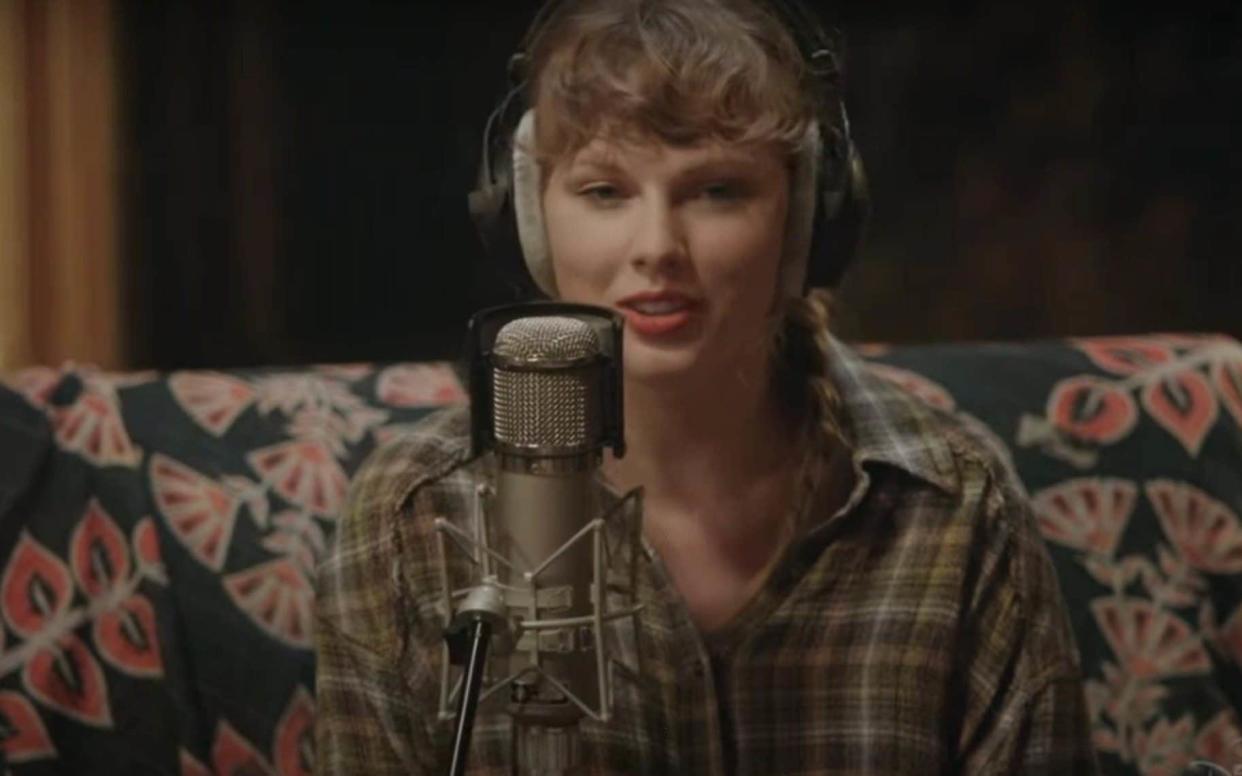Taylor Swift, The Long Pond Studio Sessions, review: a cosy fireside chat scattered with Easter Eggs

- Oops!Something went wrong.Please try again later.
Picture the scene: a remote cabin. Lush green trees all around. A fire pit. Fairy lights strung between fence posts. A bottle of white wine on the floor. And one of the world’s most famous people sitting bundled up in a coat, fidgeting with a glass as she explains that, yeah, she’s struggled this year too.
This is the setting for Taylor Swift’s new Disney+ film, Folklore: the long pond studio sessions. She announced the film’s existence just days ago, the trailer promising intimate performances of the songs from the album Folklore that she made during lockdown. The record was created with The National’s Aaron Dessner and Swift’s longtime producer Jack Antonoff, the trio trading songs via email and recording remotely.
As well as each Folklore song getting its first in-person performance, the film is peppered with fireside chats between the artists, talking about how each song came into being during one of the deadliest times in modern history. There was a danger of it turning into something self-congratulatory, a kind of “oh wow the pandemic affected me too!”. But in fact it’s a very cosy, inviting two hours of nerding out about Swift’s process on the most un-Taylor Swift album to date.
It’s not a revolutionary structure: a chat, then a song, then a chat, then a song. But it may appeal to the new fans who suddenly appreciated Swift’s work as soon as she dropped pop and went all The National, tempered with plenty of personal insight that dyed-in-the-wool Swifties will lap up (notably that the mysterious co-writer William Bowery is in fact her long-term boyfriend Joe Alwyn).
As an artist who tends to write her own life stories, Folklore is Swift’s least autobiographical album; inspirations range from sports films (she had recently watched Michael Jordan documentary The Last Dance), to her grandfather’s involvement in World War 2, the misogyny she and all women deal with, and addiction. Of course, even as every song is refracted by a world of different perspectives and experience, it’s clear that every song is in fact about Swift too.
The protagonist herself looks and sounds happy and healthy. Leaning into the cottagecore vibe of her surroundings, she’s dressed in plaid shirt dresses, brushed velvet and brown brogues (and an ill-advised purple hat but we’ll let her off). She’s been styled to look as though she’s literally camped in the wood; tousled hair and bare-face make up add to the intimate feel. Conversations don’t always feel like conversations so much as an audience with Taylor Swift, and some links are so clunky they feel like Saturday morning TV (out of nowhere: “I wish our other collaborators were here...” as a lead-in to the Joe Alwyn reveal) but it tends to come off as endearing rather than grating.
The film was also directed by Swift and it’s very beautifully done, making the most of the parallels between the luscious, remote surroundings and how they mirror the lusciousness and isolation of the songs. It also artfully impresses on the viewer the way her work has progressed over the course of making Folklore: at first she’s literal and bolshy but by the final song, Hoax, she called in help and fought to “do the thing that makes you feel uncomfortable” (which in this case was to write one song from many different topics and perspectives).
That’s not to say that Taylor Swift, the mistress of dropping clues and hints, doesn’t give stans some new tidbits to obsess about. “Everyone in my life knows what that’s about,” she says of a line from Hoax that goes, “You knew it still hurts underneath my scars/From when they pulled me apart”. Talking about “a business thing that really hurt” will no doubt lead to speculation that it’s to do with professional nemesis Scooter Braun’s ownership and sale of the master recordings of her first six albums, and comments like “I wrote [Invisible Strings] right after I sent an ex a baby gift,” will no doubt get the internet sleuths sleuthing.
Though some of the songs are obviously built on a bed of pain, the overall experience appears to have been a very positive one for both Swift and Dessner. The two are effusive about their musical chemistry and Dessner in particular still seems a little dazzled by the way Swift took his instrumentals and worked them into what they became. The performances are note-perfect; the emotional My Tears Ricochet is a highlight while it’s also pleasing to see her loosen up during less heavy numbers.
During instrumental segments she sits back, grinning at the pleasure of hearing their joint creations. Occasionally the film does dip into poor-me-ism, as with the chat before Mirrorball where Swift talks about how the attention-pleading of the bridge was written just as she found out her shows were cancelled because of the pandemic. The semi-sycophantic Jack Antonoff is on hand to say, “It’s not about the pandemic but about what happens to an artist when you’re living through a pandemic,” which is about as close-eyed as you can be to the real trials of the time. Her face hardens as she sings the bridge.
Though the songs are all fully-formed melodramas, Swift’s voice lends itself to the calm lilt of gentle folk; no big notes to hit, no exhausting dance routines, no vocal gymnastics. It’s a very warm two hours of music that gives the songs a new lease of life, like you’re hearing them in relief for the first time. I suspect by the end that causal fans will be tuckered out, but hardcore Swifties will instantly hit replay.
“That oughta do it,” Swift says as they get up after performing the final, bonus track The Lakes. “Whiskey?” After the year we’ve had, I think we’ve all earned it.

